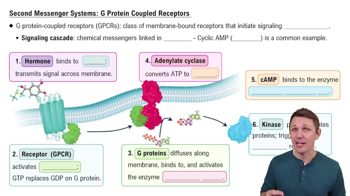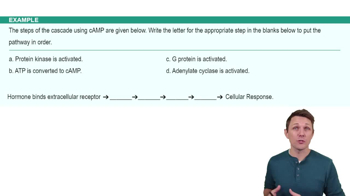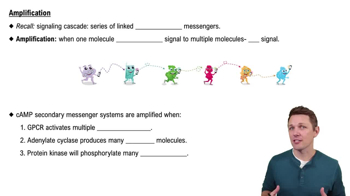Membrane Bound Receptors and Secondary Messengers definitions Flashcards
 Back
BackMembrane Bound Receptors and Secondary Messengers definitions
1/15
Terms in this set (15)
- GPCRA class of membrane-bound receptors that initiate signaling cascades, crucial for hormone signaling and other sensory functions.
- Signaling CascadeA series of linked chemical messengers that amplify a signal, similar to a waterfall gaining momentum.
- Cyclic AMPA secondary messenger produced from ATP by adenylate cyclase, crucial for activating protein kinase A.
- Adenylate CyclaseAn enzyme that converts ATP to cyclic AMP, playing a key role in the cyclic AMP signaling cascade.
- Protein Kinase AAn enzyme activated by cyclic AMP that phosphorylates proteins, triggering cellular responses.
- AmplificationThe process where a signal is increased in magnitude as it passes through a signaling cascade.
- Secondary MessengerMolecules like cyclic AMP, DAG, and IP3 that relay signals inside the cell, leading to various responses.
- DAGA secondary messenger produced by phospholipase C, involved in activating protein kinase C.
- IP3A secondary messenger that releases calcium ions from cellular stores, influencing various cellular activities.
- VasodilationThe widening of blood vessels, often triggered by cyclic AMP signaling in response to hormones like epinephrine.
- VasoconstrictionThe narrowing of blood vessels, which can be induced by different signaling pathways in response to hormones.
- G ProteinA protein activated by GPCRs that transmits signals to enzymes like adenylate cyclase in signaling pathways.
- PhosphorylationThe addition of a phosphate group to a protein by kinases, altering the protein's function and activity.
- HormoneA signaling molecule that binds to specific receptors to induce changes in target cells.
- ReceptorA protein on the cell surface or inside the cell that binds to specific molecules, initiating a cellular response.



